ISSN ONLINE(2278-8875) PRINT (2320-3765)
ISSN ONLINE(2278-8875) PRINT (2320-3765)
Juney M George1, Venugopal G1
|
| Related article at Pubmed, Scholar Google |
Visit for more related articles at International Journal of Advanced Research in Electrical, Electronics and Instrumentation Engineering
Now a day’s lot of embedded platforms are available based on different controllers for patient monitoring applications. The major disadvantage of such systems are their disability to handle multiple tasks effectively. Real Time Operating Systems(RTOS) are well known for their multitask handling ability. So the design of embedded platforms by incorporating of a Real Time Operating Systems will improve the multitask handling capability of embedded platforms. So in this paper we propose a telemedicine embedded platform based on μC/OS-II RTOS and Atmega128 AVR microcontroller.
Keywords |
| RTOS; Telemedicine; Task; Priority |
I INTRODUCTION |
| Enormous amount of human work is needed for caring a patient in critical condition in hospital. A person should always be seated beside the patient and need to monitor him continuously. In case any emergency situation arises, he must consult with the doctor and take necessary steps as per the doctor's prescriptions for saving the life of patient under critical condition. The proposed telemedicine platform using RTOS is a remedy for reducing the human work and effort needed for caring the patient without any reduction in care to the patient. The designed system will monitor the physical condition of the patient in intensive care unit under critical situation The system is designed in such a way that system itself is capable of providing necessary life saving actions if there are some variations in the physical condition like temperature, pressure ,heart beat variations of the patient . |
| Some pioneer works in the patient monitoring field are as follows. Ya-lin Miaot et.al (2005) designed a system for patient monitoring, based on ARM7 processor and real time embedded operating system (μC/OS-II), establishes an embedded telemedicine platform ground on LPC2104 and realizes some very popular embedded application technologies [1]. Peter Varady et.al (2008) proposed an open architecture patient monitoring system using standard technologies [2]. He presents an open architecture for monitoring patients in critical care units using 80386. The system composed of an artificial patient acting as signal source, beside monitor for bedside acquisition and display of the vital signals of a patient, central monitor for real-time reception of bedside data of 16 patients .The peculiar feature of the proposed system is that in the system, patient data management system is kept as a part of hospital information system. Nilima R. Kolhare et.al (2012) discussed the porting implementation of features of μC/OS-II RTOS on Arm7 controller LPC 2148 with different IPC mechanisms [3].μC/OS-II RTOS is commonly used along with the microcontrollers for implementing the features like multitasking,time scheduling, mailbox and, mutex. |
| Majority of the papers explain the design of embedded systems using microcontrollers. The major drawback of such systems is their performance will degrade on increasing the number of functions needs to be handled by them. A lot of solutions are available for performance degradation problems. Use of some new generation powerful controllers will solve this problem easily. But in such situations the cost of the system will be a major concern. Another solution is to use a combination of Real Time Operating system and a micro controller. Such a combination will be a perfect solution for high cost high performance embedded systems.Since Real Time Operating systems are well known for their time management capability .So in proposed work a new embedded platform is developed for patient monitoring applications by combining ATMEGA 128 AVR controller and a Real Time Operating system known as μC/OS-II. |
| The rest of the paper is organized as follows. Section II introduces proposed system and it’s working. Section III μC/OS-II features. IV illustrates Software implementation. Section V describes results and discussions. And the last section illustrate the future aspects of proposed system. |
II PROPOSED SYSTEM |
| The block diagram of the proposed system is shown in fig1.Automatic patient care unit has a data acquisition section near the patient side and a data storage and analyzing section on the doctor's side. Data acquisition section on the patient side consist of sensors for gathering the physiological parameters of the patient like pressure, temperature, heart beat etc.Collected parameters will be transmitted to a remote server in the doctor's room and the server is under the unique control of doctor himself. In the server side doctor is able to monitor the physical condition of the patient continuously through the remote server. Detailed block diagram of the automatic patient care unit consist of following modules. |
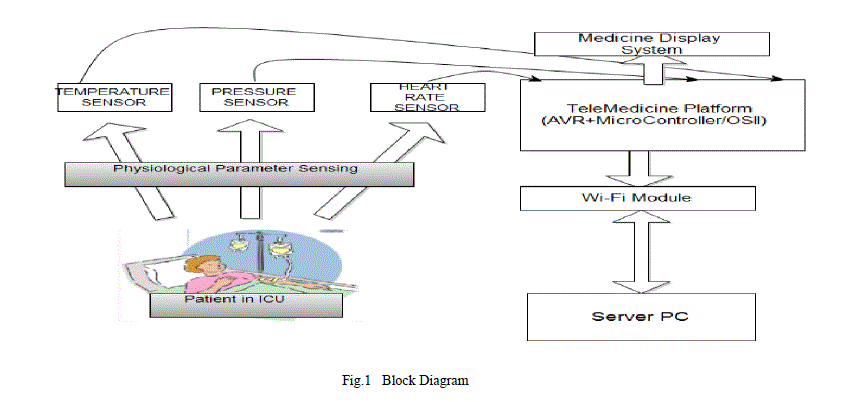 |
| They are |
| 1. Sensor section. |
| 2. AVR μC/OS-II platform. |
| 3. Medicine display System. |
| 4. Wi-Fi module. |
| Doctor's side of automatic patient care unit consists of a host system or Server PC. Entire project can be broadly categorized into three major activities. In the first activity, parameters are measured and transmitted to server pc. Second step will perform the comparison and decision making operations and the final step the doctor’s prescriptions are transmitted to the patient. A real time health monitoring system will continuously monitor the patient and parameters such as pressure, temperature and heart Beat will be continuously transmitted and monitor through wireless technology Wi-Fi. At the receiver side (doctor side) the data will be wirelessly received using Wi-Fi.[2] The doctor will monitor the measured parameter on the GUI designed using Visual Basic on PC. The data from the patient is collected continuously and gathered in the database designed using SQL (Structured Query Language) |
| On detecting the type of abnormality the doctor can sent emergency tackling information through Wi-Fi and let him know the further course of action. Sensors attached to the microcontroller(LM35-temperature,MPX 100PPressure, Heart rate sensor -Heart rate) will acquire physiological parameters of the patient like temperature, pressure and heart rate. All the collected data will gather and processed by the embedded platform consisting of AVR micro controller and μC/OS-II. After processing ,the data will be send to a remote server in the doctors room via Wi-Fi .In the server there is a GUI interface created in visual basic as shown in fig 2. |
| GUI is capable of analyzing the information sent by the controller. In case any variation in physiological parameters happens it will indicate it to the doctor by an alarm. On obtaining the emergency sign doctor can sent medicine name to beat the emergency situation via Wi-Fi method .On receiving the doctor’s message an alarm starts to run un-till case is attended by physician caring the patient. In the patient side there is a display section which will shows the monitored parameters of the patient and the prescribed medicines. Also medicines prescribed by the doctor in emergency situation will also displayed .A Real Time Clock is used for monitoring parameters based on time scheduled manner. |
| On the patient side there is a 4 line lcd display which shows the measured parameters of the patient in the first 3 lines and in the fourth line it will show the time from the RTC chip DS1307 .Fourth line of the display system is not only assigned for time but also for the medicine prescriptions from the doctor as shown in fig 3. Daily medicines for the patient will be displayed at morning 9 am afternoon 12 pm and evening 9 pm. At emergency situations prescriptions from the doctor will also be displayed for 10 seconds along with time. |
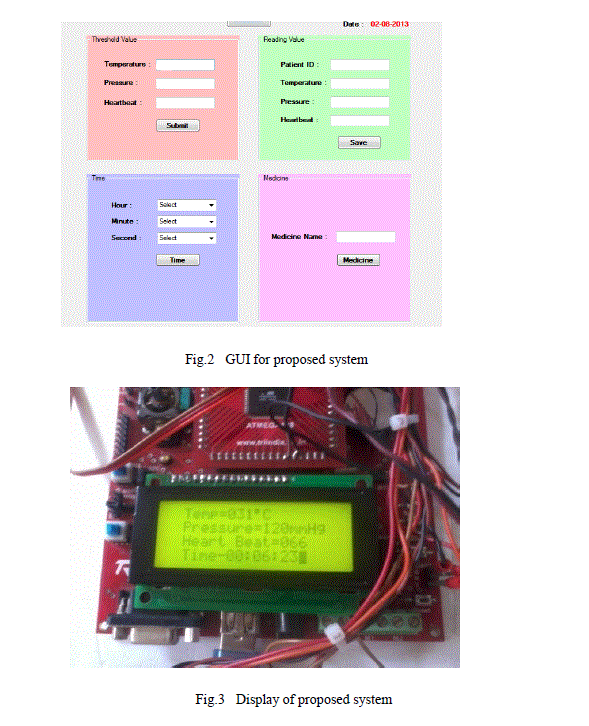 |
III μC/OS-II FEATURES |
| μC/OS-II is a deterministic, portable, preemptive, ROMable, scalable, real-time, multitasking RTOS for microcontrollers[4] . |
| Features |
| multitasking preemptive real-time kernel with optional round robin scheduling. |
| Mutual exclusion semaphores with built-in priority ceiling property |
| Timeouts on `pend' calls to prevent deadlocks phenomenon |
| Up to 254 application tasks (1 task per priority level), and unlimited number of kernel objects |
| Highly scalable OS(6K to 24K bytes code space, 1K+ bytes data space) |
| Low Interrupt Disable Time |
| Third party certifiable OS. |
IV SOFTWARE IMPLEMENTATION |
| Proposed system consist of 5 tasks with different priority of execution. They are |
| for DS1307 RTC -priority is 1 |
| for heart rate sensor priority 2 |
| for pressure sensor priority 3 |
| for temperature sensor priority 4 |
| for medicine routine display priority5 |
| An overview of the software implementation is as shown in fig 4. |
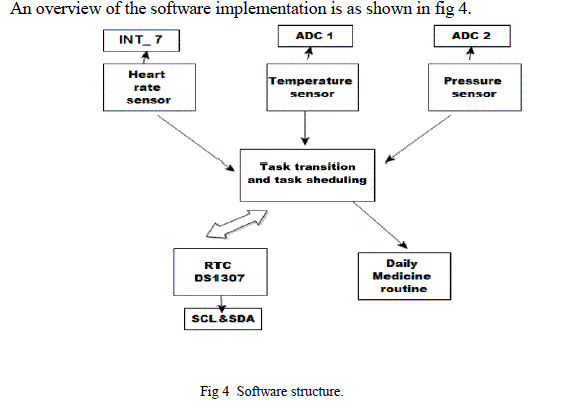 |
| Algorithm of the software implementation is as follows |
| Step 1) Include all header files. |
| Step 2) Create Task and other sub functions |
| Step 3) Define Stack for each task |
| Step 4) Define temporary variables and semaphore variables |
| Step 5) Create 5 tasks with appropriate priority. Task 5-priority 1(highest),task 3-priority 2,task 2-priority 3,task 1-priority 4,task 4-priority 5(lowest). |
| Step 6)Go to higher priority task ,task 5 and check for any desired key press, if yes go to step 7 else go to step 8 . |
| In step 8 check for any external interrupt if yes go to step 8 else go to step 9. |
| Perform the operation in step 9 and go to step 10. After completing step 10 go to step 11.After performing step 11 go to step 12. |
| Step 7)Perform operations for RTC output display and also transmit it to server-Task 5 |
| Step 8)Count heart beat and display it in every 10 seconds and also transmit it to server-Task 3 |
| Step 9)Measure pressure and display it and also transmit it to server -Task 2 |
| Step 10)Measure temperature and display it and also transmit it to server -Task 1 |
| Step 11)Display medicine at regular time intervals -Task 4 |
| Step 12)Repeat operations from step 6 |
V RESULTS AND DISCUSSIONS |
| On giving power to the system the sensors starts their operation and doctor can view these sensor values from the GUI.Patient monitoring system is a highly secure password protected system .In order to view the physical condition of the patient ,doctor need to enter the password and click on the connect tab in the GUI.The GUI screen of the proposed system is shown in fig 5. |
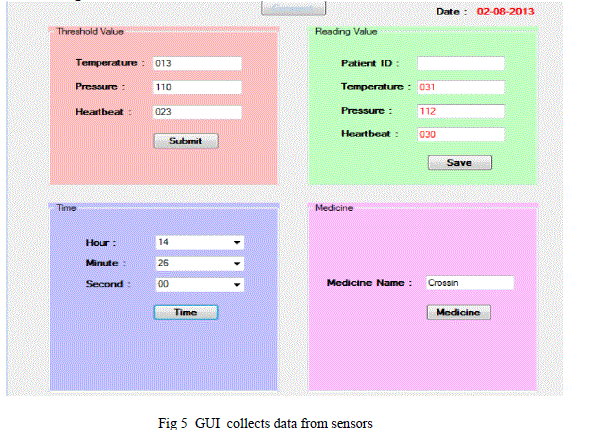 |
| The accuracy of the system is tested by measuring parameters through conventional methods and compared with the sensor reading. Results shows that the system designed with no compromise in accuracy reduction. The results of comparison study are as shown in fig 6 |
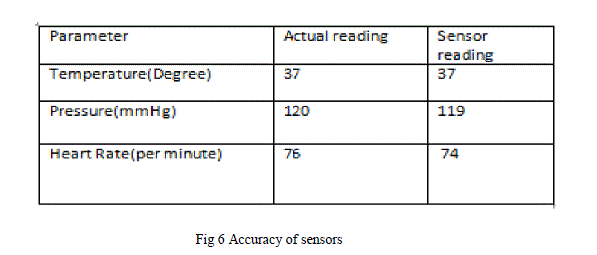 |
VI CONCLUSIONS |
| The system is based on the embedded technology of μC/OS-II RTOS in the development and research of data collection. The main goal of designing hardware is to meet the demand of low cost, low power consumption, small volume and real-time. It adopts ATMega128 micro-processor, sets up a embedded platform based on ATMega128 and μC/OS-II realizes some applications such as Wi-Fi communication, sensor interfacing etc. So the whole system performance increases greatly. The processor software is based on the embedded real-time OS and utilizes the multi task structure. The software system is more canonical and meanwhile, it is far more efficient and reliable in real running according to the demand of embedded OS and module design. |
References |
|